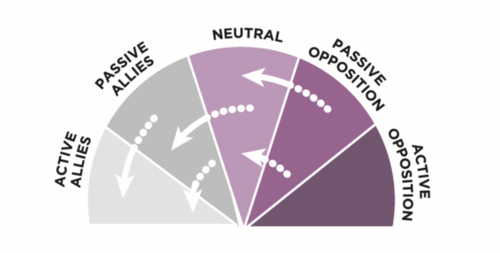Spectrum of allies: Difference between revisions
| (2 intermediate revisions by the same user not shown) | |||
| Line 9: | Line 9: | ||
== How to use the spectrum of allies == | == How to use the spectrum of allies <ref>https://beautifultrouble.org/toolbox/tool/spectrum-of-allies</ref> == | ||
{| class="wikitable" style="border-collapse: collapse; width: 100%; height: | {| class="wikitable" style="border-collapse: collapse; width: 100%; height: 79px; background-color: rgb(255, 255, 255);" | ||
|- style="height: 23px;" | |- style="height: 23px;" | ||
| style="width: 19.6976%; height: 23px; background-color: #99e1d9;" | | | style="width: 19.6976%; height: 23px; background-color: #99e1d9;" | | ||
<p>'''1. Set up the diagram (see above).''' </p> | |||
| style="width: 80.3024%; height: 23px;" | | | style="width: 80.3024%; height: 23px;" | | ||
*Label the entire drawing with the name of the specific movement or campaign you are discussing, and put yourself on the left side, with your opposition on the right side. | |||
|- style="height: 23px;" | |- style="height: 23px;" | ||
| style="width: 19.6976%; height: 23px; background-color: #99e1d9;" | | | style="width: 19.6976%; height: 23px; background-color: #99e1d9;" | | ||
<p>'''2. Divide the half-pie into five slices.'''</p> | |||
| style="width: 80.3024%; height: 23px;" | | | style="width: 80.3024%; height: 23px;" | | ||
''Place different constituencies, organizations, or individuals in each wedge. Be specific: list them with as many identifying characteristics as possible. The wedges are:'' | |||
*<p>''active allies'', people who agree and are fighting with you;</p> | |||
*<p>''passive allies'', people who agree but aren’t (yet) doing anything;</p> | |||
*<p>''neutrals'', unengaged and uninformed;</p> | |||
*<p>''passive opposition'', people who disagree but aren’t actively trying to stop you; and</p> | |||
*<p>''active opposition'', people who disagree with you and are actively organizing against you.</p> | |||
|- style="height: 23px;" | |- style="height: 23px;" | ||
| style="width: 19.6976%; height: 23px; background-color: #99e1d9;" | | | style="width: 19.6976%; height: 23px; background-color: #99e1d9;" | | ||
<p>'''3. Add specificity.'''</p> | |||
| style="width: 80.3024%; height: 23px;" | | | style="width: 80.3024%; height: 23px;" | | ||
*You might be tempted to say “students,” but the reality might be that “wealthy students who are not incurring student debt” might belong in one wedge, and “students who have taken out loans” would belong in another. The more specific you can be, the better. | |||
|- style="height: | |- style="height: 10px;" | ||
| style="width: 19.6976%; height: | | style="width: 19.6976%; height: 10px; background-color: rgb(153, 225, 217);" | | ||
<p>'''4. Start a list of follow-up questions''' </p> | |||
| style="width: 80.3024%; height: | | style="width: 80.3024%; height: 10px;" | | ||
*This step is a placeholder for further follow up research as needed. | |||
|} | |} | ||
<br> | |||
<br> | |||
If you have any suggested revisions or additional resources to share related to the above content, please email them to kenzie@lehub.ca. | If you have any suggested revisions or additional resources to share related to the above content, please email them to kenzie@lehub.ca. | ||
<br>[[File:Creative commons.png|300px|link=https://creativecommons.org/licenses/by-nc/4.0/|center|frameless]] | <br>[[File:Creative commons.png|300px|link=https://creativecommons.org/licenses/by-nc/4.0/|center|frameless]] | ||
Latest revision as of 19:03, 25 November 2022
Spectrum of allies describes a concept that examines the potential opposition and support of people and groups, ranging from those who are most dedicated opponents to the most active supporters; helpful tool for deciding what tactics to employ based on a team’s relation to specific allies. - 350.org, adapted by Michelle Xie [1]
This tool is helpful in identifying the social groups (students, workers) that are affected by your issue, and to locate those groups along a spectrum, so you can focus your efforts on shifting those groups closer to your position. The tool also encourages looking at society as a collection of specific communities, some of which can be defined as institutions (unions, churches, schools), others of which are less visible such as youth subcultures or demographic groups. Identify impacted communities can help you develop a more targeted strategy that moves groups closer to your position.

Source: George Lakey, Training for Change
How to use the spectrum of allies [2]
|
1. Set up the diagram (see above). |
|
|
2. Divide the half-pie into five slices. |
Place different constituencies, organizations, or individuals in each wedge. Be specific: list them with as many identifying characteristics as possible. The wedges are:
|
|
3. Add specificity. |
|
|
4. Start a list of follow-up questions |
|
If you have any suggested revisions or additional resources to share related to the above content, please email them to kenzie@lehub.ca.
